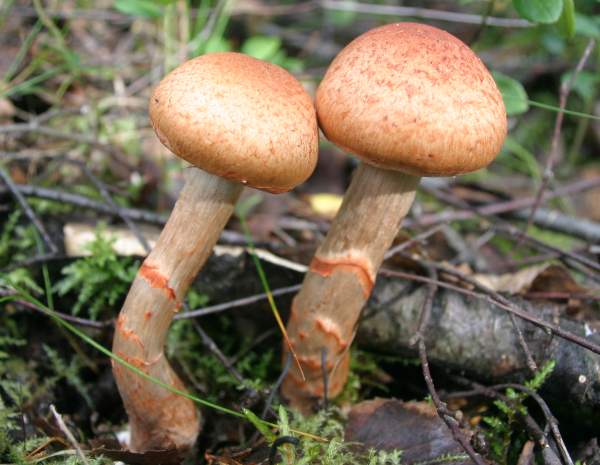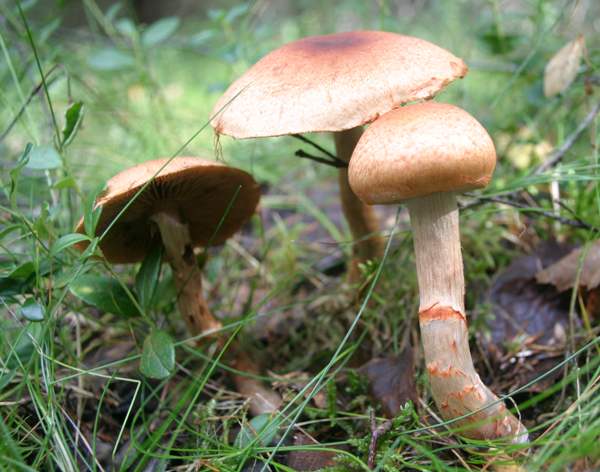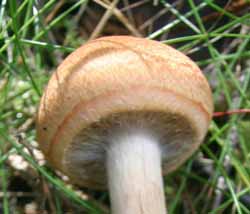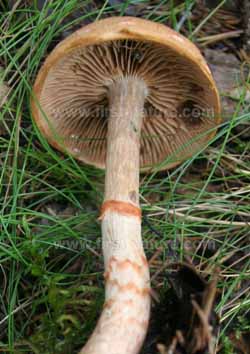Cortinarius armillatus (Fr.) Fr. - Red Banded Webcap
Phylum: Basidiomycota - Class: Agaricomycetes - Order: Agaricales - Family: Cortinariaceae
Distribution - Taxonomic History - Etymology - Toxicity - Identification - Reference Sources

In the generally difficult Cortinarius group of fungi this is one of the easiest to identify, because of the distinctive reddish veil girdles or 'bracelets' on the stems. There are usually between two and four of these girdling marks, which are nearly always very bold and easy to spot.
Distribution
In Britain and Ireland the Red-banded Webcap is one of the most common of the reddish webcaps. This distinctive webcap occurs throughout most of mainland Europe'; it is also common in eastern North America.

Taxonomic History
Cortinarius armillatus was originally described in 1818 by the great Swedish mycologist Elias Magnus Fries, who named it Agaricus armillatus. (Most gilled fungi were initially placed in a giant Agaricus genus, now redistributed to many other genera.) In 1938 Elias Fries transferred this species to the genus Cortinarius, where it has resided to the present day.
Synonyms of Cortinarius armillatus include Agaricus armillatus Fr. and Cortinarius haematochelis sensu Cooke.
Etymology
The generic name Cortinarius is a reference to the partial veil or cortina (meaning a curtain) that covers the gills when caps are immature. In the genus Cortinarius most species produce partial veils in the form of a fine web of radial fibres connecting the stem to the rim of the cap.
The specific epithet armillatus means 'wearing bracelets' or 'wearing collars' - in this instance the reddish veil girdles around the stem of this mushroom.
Toxicity
Like a number of other fungi in the Cortinarius genus but by no means the majority, this mushroom is not generally reputed to be poisonous and some authors describe it as 'edible but not choice'; however, it could be confused with some of the reddish webcaps that contain orellanine and are known to be deadly poisonous. For this reason we recommend that it should not be gathered for eating.
Identification guide
 |
CapThe cap is at first reddish-brown and globe-shaped with a web-like cortina covering the gills, becoming bell-shaped and then flattening and becoming darker at maturity, but usually retaining a small central umbo; its surface is dry with radial reddish scales, darkest in the centre of the cap and paler towards the margin. Cap diameter at maturity varies from 4 to 12cm. |
 |
GillsAt first pale cinnamon, the gills become stained rusty brown as the spores mature. StemThe pale, fibrous stem is 1 to 2.5cm in diameter and very variable in height - from 5cm to 15cm - with a slightly swollen club-shaped base. |
SporesEllipsoidal, 9-12 x 5-7µm; covered in small warts; dextrinoid. Spore printRusty reddish-brown. |
|
Odour/taste |
Slight smell of radish. (It is unwise to taste any Cortinarius species, as several of them are deadly poisonous.) |
Habitat & Ecological role |
Ectomycorrhizal, on acid soil under birch trees and in mixed woodland containing birches. |
Season |
July to November in Britain and Ireland. |
Similar species |
Although lacking the distinctive orange bands on the stem, several common webcaps resemble Cortinarius armillatus. Among these are Cortinarius bolaris, which is poisonous, and Cortinarius rubellus which is deadly poisonous. |
Reference Sources
Fascinated by Fungi, 2nd Edition, Pat O'Reilly 2016, reprinted by Coch-y-bonddu Books in 2022.
Funga Nordica, Henning Knudsen and Jan Vesterholt, 2008.
Dictionary of the Fungi; Paul M. Kirk, Paul F. Cannon, David W. Minter and J. A. Stalpers; CABI, 2008
Taxonomic history and synonym information on these pages is drawn from many sources but in particular from the British Mycological Society's GB Checklist of Fungi.
Fascinated by Fungi. Back by popular demand, Pat O'Reilly's best-selling 450-page hardback book is available now. The latest second edition was republished with a sparkling new cover design in September 2022 by Coch-y-Bonddu Books. Full details and copies are available from the publisher's online bookshop...

